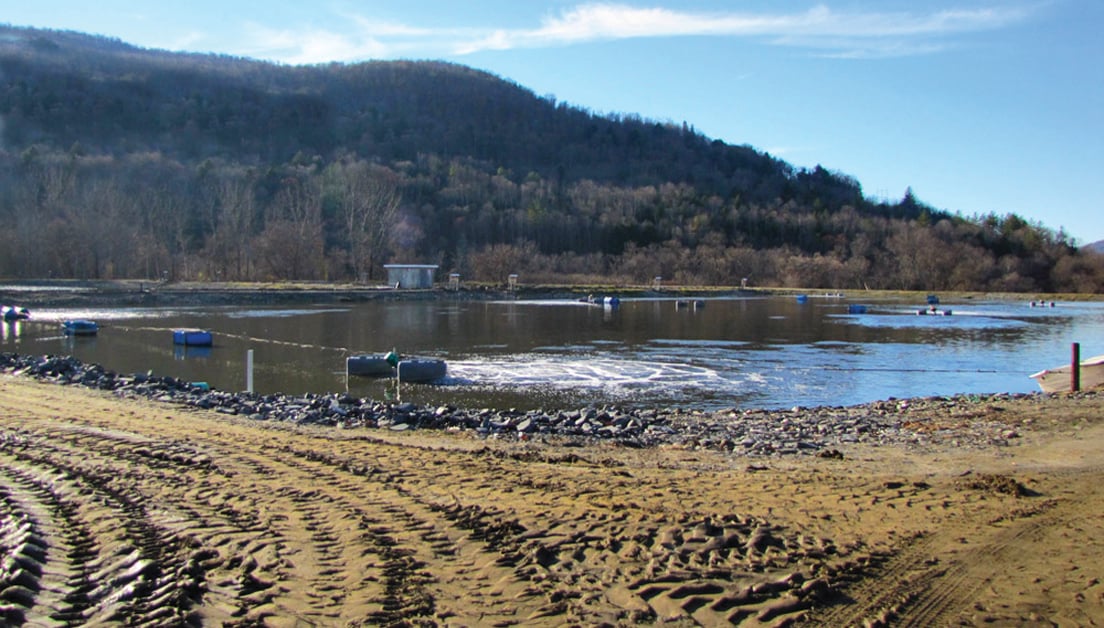Challenge
The Village of Waterbury Wastewater Treatment Plant (WWTP) is located on the Winooski River floodplain, which poses challenges from significant flooding during the spring runoff and storm seasons to strong algal blooms in late spring. During algal blooms, the plant encounters bright green lagoon effluent high in total suspended solids(TSS), resulting in treatment upsets and inconsistent permit compliance.
 The CoMag System operates successfully under high TSS stress conditions during the algal bloom peak for Waterbury’s WWTP. During the 2015 algal outbreak, the TSS average reduction was 86 percent with a peak TSS from the lagoon of 353 mg/L. Phosphorus removal achieved an average reduction of 96 percent with a peak TP of 5.7 mg/L coming from the lagoon.
The CoMag System operates successfully under high TSS stress conditions during the algal bloom peak for Waterbury’s WWTP. During the 2015 algal outbreak, the TSS average reduction was 86 percent with a peak TSS from the lagoon of 353 mg/L. Phosphorus removal achieved an average reduction of 96 percent with a peak TP of 5.7 mg/L coming from the lagoon.Solution
Tertiary treatment needed
In 2010, the Village and its engineer, Stantec, evaluated a tertiary treatment system to polish its lagoon effluent with the flexibility to meet the current total phosphorus (TP) limit of 0.8 mg/L TP, as well as the foreseen ultra-low limit of 0.2 mg/L TP. The Village selected the CoMag® System because it meets stringent TP limits in a small footprint and can handle wide fluctuations in feed TP and total suspended solids (TSS) concentrations, as well as wide swings in flow rates and treatment demands.
 The CoMag™ System dramatically reduced algae in the Waterbury WWTP lagoon effluent. The photo shows a sample of the influent before treatment on the left and a sample of the effluent after CoMag system treatment on the right.
The CoMag™ System dramatically reduced algae in the Waterbury WWTP lagoon effluent. The photo shows a sample of the influent before treatment on the left and a sample of the effluent after CoMag system treatment on the right.The CoMag System is a high-rate ballasted clarification technology that settles chemical floc up to 30 times faster than conventional clarification. The System infuses magnetite (a readily available iron ore) as a weighting agent into the floc.
Plant investment costs are reduced because rapid and reliable settling, which increases treatment capacity, can be achieved with existing tanks. Additionally, because 99 percent of the magnetite ballast is easily recovered, the CoMag System is sustainable and cost-effective to operate.
Results
A successful pilot
The Village piloted the CoMag System in 2012 which proved it could meet TSS and TP targets under all conditions, including high flow and high solids stress tests. In addition, the System reduced biochemical oxygen demand (BOD), turbidity and E. coli levels.
Full-scale operating results
Based on the pilot results, the Village proceeded with a full-scale CoMag System installation in September 2014, which immediately met the plant’s current effluent TP limit of 0.8 mg/L. The Village conducted a process performance test to:
• Demonstrate the ability to meet the future 0.2 mg/L TP limit;
• Test the system at design and maximum flowrates; and
• Adjust the system (increasing and decreasing the coagulant dose) to provide operating set points and conditions for the plant to meet the current 0.8 mg/L TP limit.